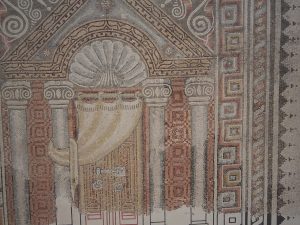
Mosaic in Samaritan Synagogue. By Davidbena – Own work, CC BY-SA 4.0, https://commons.wikimedia.org/w/index.php?curid=66143475
When the Ta‘âmireh bedouin penetrated the Daliyeh cave (as described in the previous article by Paul Lapp) they found within more than 300 skeletons lying on or covered by mats. The bones were mixed with fragments of manuscripts. These manuscripts were not burial documents, but everyday business records. The artifacts found in the cave were not traditional burial objects, but ordinary things for daily use. A grim conclusion seems clear. The Daliyeh cave was not a burial ground but, rather, a refuge which murder turned into a tomb.
The best hypothesis to explain the 300 skeletons or more found by the Ta‘âmireh seems to be that a large number of refugees fled to the cave and were then discovered by their pursuers, who built a large fire at the mouth of the cave and succeeded in suffocating everyone inside. The covering with matting might have been the last tender act by survivors of the catastrophe.
Can we go further and suggest a more specific historical background to this holocaust?
Since the dating evidence, which I shall discuss later, suggests that the dread event occurred during the last third of the fourth century B.C., it is there that our historical attention must be focused. A precise occasion easily suggests itself.
Read the rest of The Historical Importance of the Samaria Papyri in the online Biblical Archaeology Society Library.